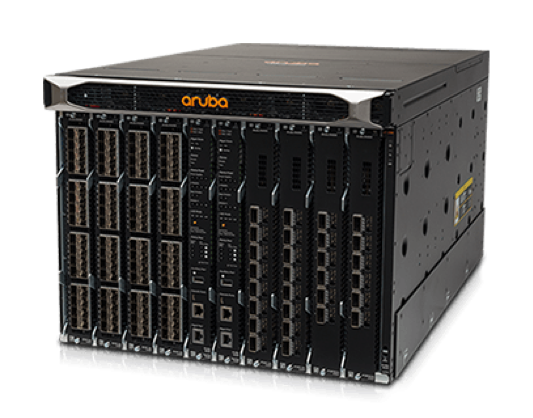By Andrea Mauro, contributor
What are stackable switches?
In networking, the term “stack” (or stackable) refers to a group of physical switches that have been cabled and grouped into a single logical switch. Over the years, stacking features have evolved from a premium (and costly feature) to a core capability of almost all enterprise-grade switches (and also in several SMB models).

A stack of switches (in this example HPE Aruba Networking CX 6300 Switch Series)
A different approach for deploying a grouping of switches as a single logical switch is to have a physical chassis with several slots and modules that can be inserted and swapped to grow your switch, used typically, in a campus, but increasingly in aggregation and access as well.

A modular chassis switch (in this example: HPE Aruba Networking 8400 Switch Series)
Both approaches can provide a single management and control plane or at least a single configurable logical switch, with redundancy if you happen to lose a physical switch or a module.
Having a single logical switch, with better reliability, makes it easy to translate the logical network topology in physical topology.
What are stacking technologies?
For stackable switches, the stack is usually built with cables that connect all the switches in a specific topology.
Those cables are connected to specific ports of the switches, depending on the type of stacking:
- Backplane stacking (BPS), where specific stacking modules (usually on the back of the switch) are used with specific cables (depending on the vendor).
- Front-plane stacking (FPS)-VSF, standard Ethernet ports are used to build the stack, using standard Ethernet cables.
The stacking topology also defines the resiliency of the stacked solution, you may have different cabling options (depending on the switch vendor and models):
- Daisy chain or bus is not usually used because it does not provide resiliency
- Ring or redundant dual ring provide resiliency, but with more than two switches the packet paths can be not optimal
- Mesh or full mesh provide higher resiliency and also optimal packet paths
For example, the HPE Aruba Networking 3810 Switch Series uses front plane VSF stacking and supports all those topologies.
In the ring topology, each stack member has a VSF link to two other members, providing resiliency against link and member switch hardware failures as any single failure does not isolate remaining stack members from each other.

HPE Aruba Networking CX 6300 Switch Series stacking: ring topology
Why use stacking?
One of the major benefits of using stacking (depending on the vendor) is the logical switch view with a single management interface. This makes management and operational tasks more simple as you do not need to manage and configure each individual switch.
It also provides link aggregation capability between ports of different physical switches in the same stack, providing better bandwidth and resiliency for the downstream links, and simplifying network design implementation, where “multiple cables” across switches are just one single logical link (using LAG, LACP, EtherChannel or any link aggregation solutions).
Compared to the modular switch option, stackable switches provide a less expensive option (especially for SMB use cases), while maintaining similar scalability and flexibility. Resiliency and performance can be different (worse or better) depending on the implementation.
With regards to flexibility, you can usually mix a combination of different port speed and media types, but also mix different models of switches with different capabilities (for example, some switches with PoE for connecting clients or IoT).
Talking about performance, stacking switches doesn't necessarily mean an increase in performance. This depends on the stacking cables' bandwidths and the stacking topology.
Why shouldn’t you use stacking?
The stackable switch market is very mature and relatively stable. However, each vendor adds its unique set of features and functionalities. Different vendors utilize different types of connectors, cables, and software for their stackable switches. This causes requirements to use the same product line of switches to take advantage of stacking (not necessarily the same model, because, for example, in the HPE Aruba Networking CX 6300 Switch Series you can mix different models in the same stack).
Still, there are potential disadvantages when you use stacked switches:
- Performance: For SMB use cases, the stack ports and cable speed are enough to provide high bandwidth and low latency. But when speed increases or the stack expands (unless you use a mesh topology) you may increase the latency and decrease the overall performance. It's important then to know not only the capabilities of the solution, but also how it can grow and expand in the future.
- Resiliency: Depending on the stacking topology, if you have some faults your overall stack may not operate correctly. So be sure to choose the best topology and ensure higher resiliency on each stack member. For example, using dual power supplies to ensure hardware redundancy. The single management or control plane may also reduce the overall resiliency in the case of connectivity loss to the conductor.
- Manageability: The single management interface is great, but there are also some drawbacks. First, expanding an existing stack could cause a service disruption for an extended period, such as when all the switches are rebooted to add a stack member or from a power failure. Second, removing a switch from a stack could be tricky or require a complex process. Last but not least, upgrading the firmware on all the stack members, in most cases, requires a complete reboot of all the switches.
Stacking evolution
Modern switches are designed for high availability, using solutions like virtualization, separation of management and control planes, and an architecture built with micro-services to help address the potential disadvantages of stacking. Usually, these are implemented on higher-end switch models, but they may also be found on other models as the technology continues to develop.
Each vendor has its proprietary solution, so understanding their capabilities is an important step in building your short-list and making a decision that will serve you now and in the years to come.
Related Content
HPE Aruba Networking Switches Series overview




